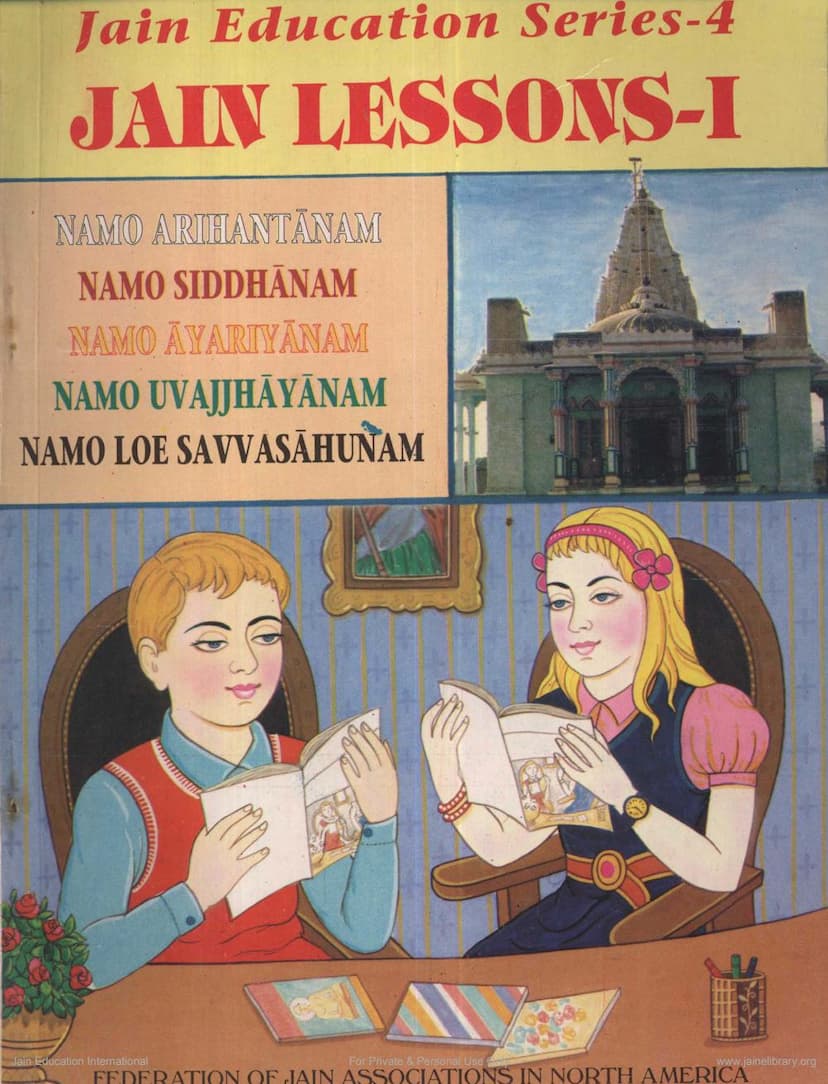Jain Lesson I
Added to library: September 2, 2025

Summary
Here's a comprehensive summary of the Jain text "Jain Lesson I," based on the provided pages:
Overview and Purpose:
"Jain Lesson I" is part of the Jain Education Series, developed by the JAINA Education Committee. Its primary goal is to provide a standardized curriculum for Jain children and youth to learn about their religion. The book is designed for children aged 3-7 and is part of a larger set of eight books for this age group. The overarching aim is to instill Jain principles and values from an early age, fostering a deeper understanding and practice of Jainism. The syllabus is intended to be common across all Jain sects, with an effort made to represent each.
Structure and Content:
The book is structured into a series of lessons, each focusing on a specific aspect of Jainism, its history, ethics, and practices. The lessons are presented in a child-friendly manner, often through stories, dialogues, and simple explanations.
Key Themes and Lessons:
The book covers a wide range of essential Jain teachings and practices, including:
-
The Namokār Mantra (Lesson 1 & 2): This foundational mantra, which expresses reverence to the Arihants, Siddhas, Acharyas, Upadhyayas, and Sadhus, is introduced in detail. Its significance as a destroyer of sins and the foremost auspicious chant is highlighted. The importance of reciting it daily, especially in the morning, is emphasized.
-
Family and Daily Practices (Lesson 3, 16, 17, 18):
- Family Values: The importance of greeting family members, respecting parents, and contributing to household chores is stressed.
- Daily Habits: Children are encouraged to cultivate good habits like reciting prayers, being kind, helpful, truthful, and respectful.
- Dos and Don'ts: Clear lists of positive actions to take and negative actions to avoid are provided, covering everything from greetings and respect to diet and honesty.
-
Jain Places and Practices (Lesson 4, 13):
- Jain Temple: The book describes the Jain temple as a peaceful place for worship. It outlines proper etiquette, such as removing shoes, maintaining silence, praying quietly, and showing respect when leaving. The concept of making donations is also introduced.
- Jain Center: The Jain Center is presented as a community hub where people pray, meditate, study religious texts, and learn about Jainism through lectures from monks and nuns.
-
Core Jain Principles:
- Ahimsa (Non-violence): This is a central theme woven throughout the book. Various lessons emphasize the importance of not hurting or killing any living being, including animals, birds, and insects. This extends to dietary choices and even actions like not picking flowers or leaves unnecessarily.
- Vegetarianism (Lesson 7, 8, 9): Jains are strictly vegetarian, abstaining from meat, poultry, fish, and eggs. The lessons explain why this is so, linking it to the principle of Ahimsa. Children are taught to check ingredient labels for animal products.
- Truthfulness (Satyavāda): Telling the truth is consistently promoted as a key virtue.
- Non-stealing (Asteya): Taking anything without permission is forbidden.
- Celibacy (Brahmacharya): While not explicitly detailed in all lessons, the renunciation of worldly pleasures by monks and nuns implies this vow.
- Non-possession/Non-attachment (Aparigraha): Controlling desires and possessing only what is needed is encouraged.
-
Ethical Behavior and Character Development:
- Compassion and Kindness: Stories like "The Compassion of the Elephant" and the actions of Abraham Lincoln highlight the importance of empathy and helping those who are suffering, including animals.
- Honesty and Integrity: The story of Monk Metarya demonstrates the immense strength of character and adherence to truth, even in the face of extreme suffering.
- Courage and Bravery: Prince Vardhaman's encounter with the snake and the monster illustrates the value of being fearless and calm.
- Respect for Elders and Teachers: This is repeatedly emphasized in the "Dos" section.
- Sharing and Generosity: The story of Laxmiben exemplifies selfless giving and generosity towards those in need.
-
Historical Figures and Stories:
- Lord Mahavir (Vardhaman): The book introduces Lord Mahavir, the 24th Tirthankar, through stories that highlight his strength, fearlessness, and compassion. His transformation from Prince Vardhaman to Mahavir is recounted.
- Prince Nemkumar: His story illustrates the principle of compassion for animals and the renunciation of worldly life for spiritual pursuits.
- Monk Metarya: His sacrifice to protect a bird demonstrates unwavering commitment to Ahimsa.
- Abraham Lincoln: Included as an example of kindness, humility, and truthfulness in leadership.
- Soma: A story about unwavering faith and the practice of Jain principles in the face of adversity.
- Shri Krishna: Presented as an example of profound compassion towards all living beings.
-
Spiritual Teachers (Monks and Nuns): Lesson 20 provides insight into the role and characteristics of spiritual teachers, their renunciation of worldly life, and their dedication to vows, emphasizing their focus on spiritual upliftment.
-
Questions: The book concludes with a comprehensive list of questions for each lesson, designed to reinforce learning and encourage active recall of the material presented.
Overall Message:
"Jain Lesson I" aims to equip young Jains with a foundational understanding of their religion. It emphasizes the importance of living a life guided by core Jain principles, particularly Ahimsa, truthfulness, and compassion, while fostering a strong connection to their faith and community. The book serves as a building block for further religious education.